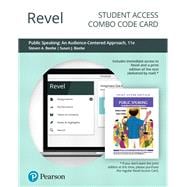For courses in public speaking.
A guide to preparing and presenting speeches with the listener in mind
Revel™ Public Speaking: An Audience-Centered Approach is a practical and user-friendly guide to help speakers connect with their listeners. Authors Steven and Susan Beebe emphasize the importance of analyzing and considering the audience at every point in the speech-making process. By focusing student attention on the dynamics of diverse audiences, ethics, and communication apprehension, the text prepares students for giving speeches while keeping their listeners foremost in mind. The 11th Edition includes new speech examples that model effective public speaking, as well as updated content that helps students better understand contemporary communication opportunities and challenges. In addition, each chapter has been revised with new examples, illustrations, and references to the latest research conclusions.
Revel is Pearson’s newest way of delivering our respected content. Fully digital and highly engaging, Revel replaces the textbook and gives students everything they need for the course. Informed by extensive research on how people read, think, and learn, Revel is an interactive learning environment that enables students to read, practice, and study in one continuous experience – for less than the cost of a traditional textbook.
NOTE: This Revel Combo Access pack includes a Revel access code plus a loose-leaf print reference (delivered by mail) to complement your Revel experience. In addition to this access code, you will need a course invite link, provided by your instructor, to register for and use Revel.









